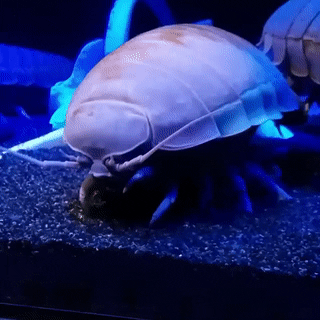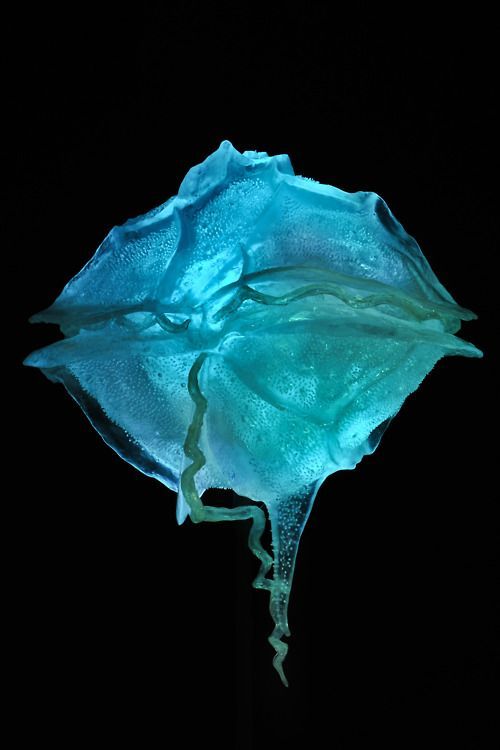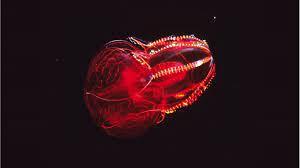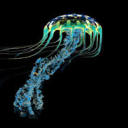Pink Helmet


Pink Helmet
Aglantha digitale
The Pink Helmet is a mini hydromedusa that comes in a variety of vibrant colors. The tiny jelly is only 4 cm in size and is found towards the surface of the ocean. The purple and blue hues we see in its bell are caused by a phenomenon known as iridescence, when light strikes the jelly’s thin tissue at different angles (similar to what we see in a soap bubbles). It also has orange pigmentation near its mouth; this pigmentation helps attract prey and mask luminescence. Furthermore, females tend to be more colorful than males.
Photo credit: https://biolum.eemb.ucsb.edu/organism/pictures/aglantha.html
https://www.pinterest.com/pin/186899453255850798/
More Posts from Bioluminescentoceangoddess and Others

Periphyllopsis braueri
The Periphyllopsis braueri is a tiny, deep sea jellyfish that is only 6 cm in diameter. It is red-chocolate in color, and it has eight gonads. Furthermore, it is found at depths between 600m to 1000m.
Photo credit: https://oceanexplorer.noaa.gov/explorations/19gulfofalaska/logs/aug2/aug2.html

Pram Bug
Phronima sedentaria
The Pram Bug is a deep sea amphipod that is located between 200 to 1000m in the ocean. It has a translucent exoskeleton and can see primarily blue light. It is also is contained in a hollowed out barrel that is used for protection and to house babies. The image above is a female pram bug carrying its young.
Photo Credit:https://ocean.si.edu/ocean-life/invertebrates/phronima-female-and-young


Giant Isopod
Bathynomus kensleyi
The Giant Isopod is an unsettling deep sea creature that crawls along the ocean floor scavenging for animal remains and detritus. These invertebrates are part of phenomenon known as abyssal gigantism, which is the tendency for deep-sea dwelling invertebrates to be larger than their shallower-water counter parts. The Giant Isopod is found between 310m to 2140m in the ocean.
Photo credit
https://seatrench.tumblr.com/post/615873390014791680/giant-isopod-bathynomus-sp-source
https://alchetron.com/Giant-isopod


Pyrodinium bahamense
Pyrodinium bahamense is a tropical species of dinoflagellates that is found primarily in Atlantic Ocean waters. It prefers salinity around 20 psu and blooms when there are large amounts of nitrogen in the water. The dinoflagellate glows bright blue when agitated by motion. Furthermore, even though this plankton species is beautiful to look at, it causes seafood toxicity.
Photo credit: https://alchetron.com/Pyrodinium-bahamense
https://wonderchews.com/bodies-of-light/


Pacific Viperfish
Chauliodus macouni
The Pacific Viperfish looks intimidating with its sharp, pointy teeth and large jaws. However, its body is small and elongated. It can be found at depths ranging from 250m to 4390m. The Pacific Viperfish long teeth are an unique adaptation designed to keep prey trapped, but it is dangerously close to its eyes. There have been instances when they have caught prey that are too large to swallow and it dies along with its last meal. The Pacific Viper also has photophores along its body and a light organ near its dorsal fin. These organs exhibit bioluminescence and help with attracting pray: as well as, communicating with mates and confuse predators. It is one of the most ferocious predators of the deep ocean.
Photo credit: https://www.science-rumors.com/top-20-pacific-viperfish-facts-to-know-what-this-creature-is/
https://goldfisho.com/everything-you-need-to-know-about-viperfish/


Piglet Squid
Helicocranchia pfefferi
The Piglet Squid is a very small and delicate, transparent squid. It is found at depths between 400 to 1000 m. It has an unique siphon that is used for jet propulsion and it resembles a pig muzzle. The young piglet squids tend to live close to the surface, and steadily migrates downward as they grow. This behavior is called ontogenetic migration.
Photo credit: http://photo.cctv.com/2019/07/23/PHOAKMEBh8xJRaHXEUIGx8kE190723.xml
https://www.ourbreathingplanet.com/banded-piglet-squid/

Brittle Stars
Asteroschema Ajax
Brittle stars are in the phylum Enchinodermata and are closely related to sea stars. They have long stringy arms and small podia on the bottoms of their body. They also have a hydrostatic skeleton and have a complex water vascular system. When attacked, they will abandon their arm to confuse predators and make a hasty escape. The photo above is a deep sea brittle star that lives in coral reefs.
Photo credit: https://species.wikimedia.org/wiki/Asteroschema_ajax
An amazing glowing ctenophore!


Bloody-belly comb jelly
Lampocteis cruentiventer
The Bloody-belly is a 16 cm ctenophore that is found at depths 700 m to 1200m. It is crimson red in color and appears black in the deep ocean. However, the jelly has the ability to emit a different color. Furthermore, it uses highly iridescent ctenes to propel through the water.
Photo credit: https://laughingsquid.com/bloody-belly-comb-jelly/
https://www.reddit.com/r/deepseacreatures/comments/2j1717/bloodbelly_comb_jelly_lampocteis_cruentiventer/


Physonect Siphonophore
Nanomia cara
The Physonect siphonophore has tiny, bubble shaped sacs that are filled with gas. The sacs are called pneumatophores and help this creature move through the deep ocean. It also has venomous tentacles that stun prey and over eighty stomachs. There are numerous amounts of these strange creatures along the east coast, and they have cause some fisheries to collapse. Furthermore, they can be found at depth between 400m to 1000m.
Photo credit: http://www.seawater.no/fauna/cnidaria/cara.html
https://www.mindenpictures.com/stock-photo-siphonophore-hydrozoan-cnidarian-nanomia-cara-atlantic-nectophores-naturephotography-image90194961.html
Dear ocean enthusiast and supporters,
Hi everyone, thank you for supporting my blog. I have gained over 500 followers and that is worth celebrating. I will try my best to post every day some of the amazing creatures that live in the deep ocean. Have a great night!
-
 stitchlover0112 liked this · 1 month ago
stitchlover0112 liked this · 1 month ago -
 daydreaming-in-daisies reblogged this · 1 month ago
daydreaming-in-daisies reblogged this · 1 month ago -
 nerialter liked this · 1 month ago
nerialter liked this · 1 month ago -
 blue-reimu reblogged this · 2 months ago
blue-reimu reblogged this · 2 months ago -
 centeotl888-blog liked this · 7 months ago
centeotl888-blog liked this · 7 months ago -
 ronrikei reblogged this · 1 year ago
ronrikei reblogged this · 1 year ago -
 ronrikei liked this · 1 year ago
ronrikei liked this · 1 year ago -
 rokuroku liked this · 1 year ago
rokuroku liked this · 1 year ago -
 rokuroku reblogged this · 1 year ago
rokuroku reblogged this · 1 year ago -
 s0ph-3 liked this · 1 year ago
s0ph-3 liked this · 1 year ago -
 moths-in-a-sweater liked this · 1 year ago
moths-in-a-sweater liked this · 1 year ago -
 mycellpics reblogged this · 1 year ago
mycellpics reblogged this · 1 year ago -
 mycellpics liked this · 1 year ago
mycellpics liked this · 1 year ago -
 doyouknowmypoetry liked this · 1 year ago
doyouknowmypoetry liked this · 1 year ago -
 nanncaconsrapsce liked this · 1 year ago
nanncaconsrapsce liked this · 1 year ago -
 sandstone72 liked this · 1 year ago
sandstone72 liked this · 1 year ago -
 comrade-slugcat reblogged this · 1 year ago
comrade-slugcat reblogged this · 1 year ago -
 cyanociitta reblogged this · 1 year ago
cyanociitta reblogged this · 1 year ago -
 0riginal-sharing liked this · 1 year ago
0riginal-sharing liked this · 1 year ago -
 blindedseraphim liked this · 2 years ago
blindedseraphim liked this · 2 years ago -
 wildernestt reblogged this · 2 years ago
wildernestt reblogged this · 2 years ago -
 protectorofoceans reblogged this · 2 years ago
protectorofoceans reblogged this · 2 years ago -
 mawsteeth liked this · 2 years ago
mawsteeth liked this · 2 years ago -
 thezenofbrutality liked this · 2 years ago
thezenofbrutality liked this · 2 years ago -
 filthyflower18 reblogged this · 2 years ago
filthyflower18 reblogged this · 2 years ago -
 spooky-alien liked this · 2 years ago
spooky-alien liked this · 2 years ago -
 ancientsharkbones liked this · 2 years ago
ancientsharkbones liked this · 2 years ago -
 mecha-droid liked this · 2 years ago
mecha-droid liked this · 2 years ago -
 justlikejohn liked this · 2 years ago
justlikejohn liked this · 2 years ago -
 tt-squid reblogged this · 2 years ago
tt-squid reblogged this · 2 years ago -
 ironmaidumb liked this · 2 years ago
ironmaidumb liked this · 2 years ago -
 oh-nostalgiaa liked this · 2 years ago
oh-nostalgiaa liked this · 2 years ago -
 the-faceless-bride liked this · 2 years ago
the-faceless-bride liked this · 2 years ago -
 allatariel liked this · 2 years ago
allatariel liked this · 2 years ago -
 melyzard reblogged this · 2 years ago
melyzard reblogged this · 2 years ago -
 welcome-to-the-landfill liked this · 2 years ago
welcome-to-the-landfill liked this · 2 years ago -
 tt-squid reblogged this · 2 years ago
tt-squid reblogged this · 2 years ago -
 catsrcoolyeet reblogged this · 2 years ago
catsrcoolyeet reblogged this · 2 years ago -
 catsrcoolyeet liked this · 2 years ago
catsrcoolyeet liked this · 2 years ago

Bioluminescence is a chemical reaction that produces light. Many deep sea animals use bioluminescence. This blog is dedicated to educating the public about the amazing creatures that thrive in the deep sea.
57 posts